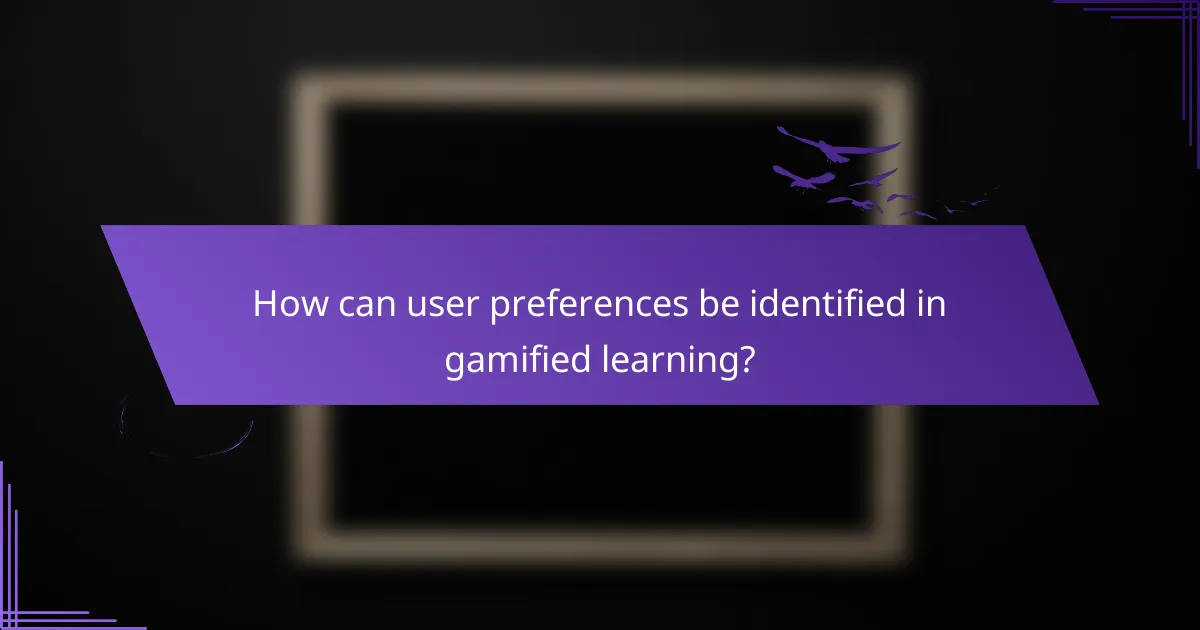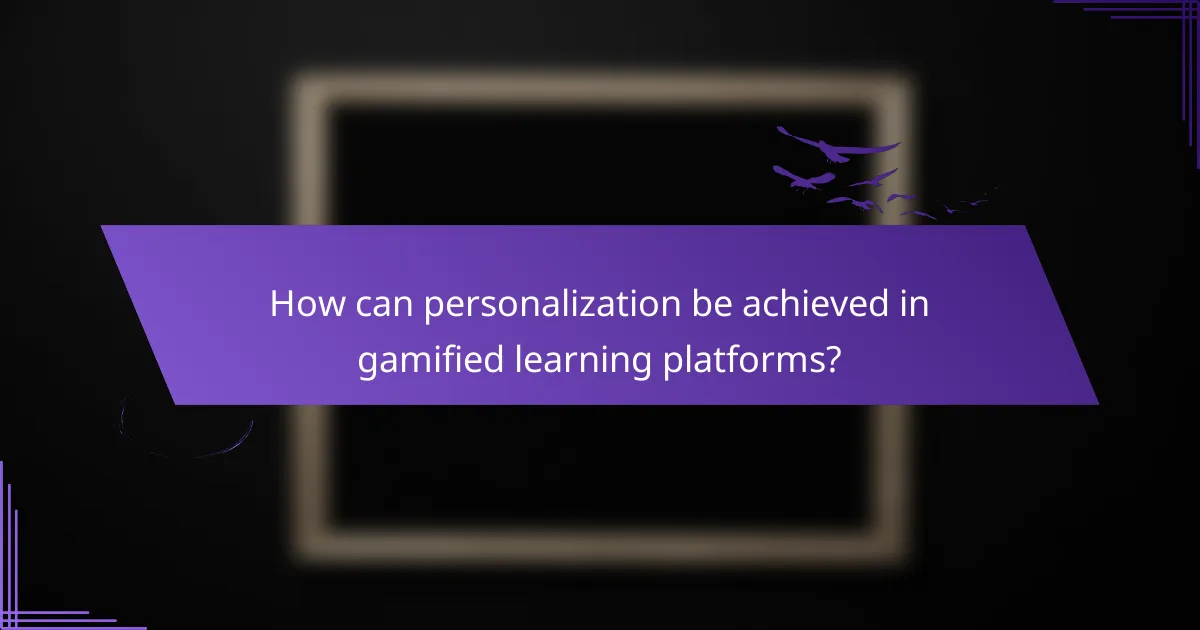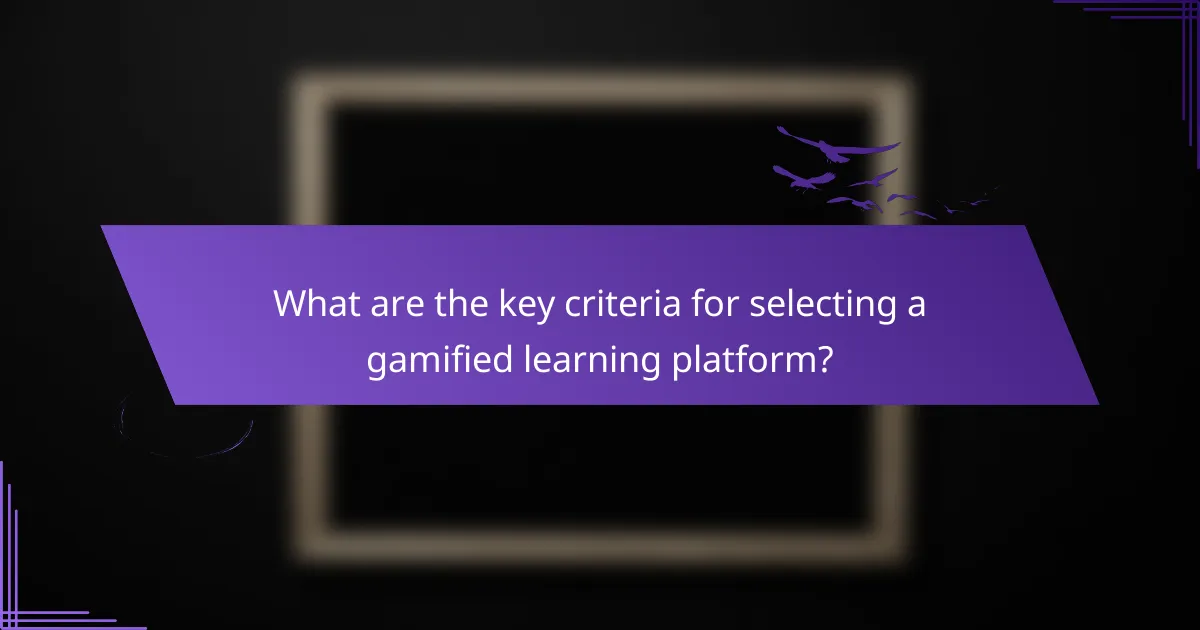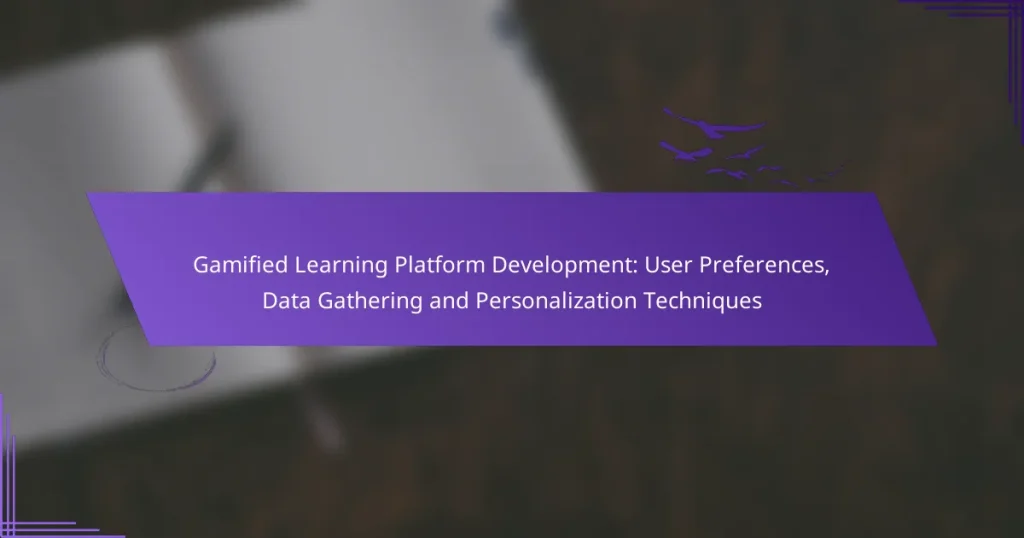Gamified learning platforms are designed to boost engagement and retention by incorporating interactive elements that cater to diverse learning styles. By understanding user preferences through data gathering techniques, developers can create personalized educational experiences that enhance both satisfaction and learning outcomes.

What are the best gamified learning platforms for online courses?
The best gamified learning platforms for online courses enhance engagement and retention through interactive elements. These platforms cater to various learning styles and subjects, making education more enjoyable and effective.
Kahoot! for interactive quizzes
Kahoot! is a popular platform that allows educators to create interactive quizzes that students can answer in real-time. This tool promotes competition and collaboration, making learning fun and engaging.
To maximize its effectiveness, educators should design quizzes that align with learning objectives and encourage participation. Avoid overly complex questions to maintain student interest and ensure comprehension.
Classcraft for role-playing elements
Classcraft transforms the learning experience into a role-playing game where students can create characters and earn rewards for positive behavior and academic achievements. This approach fosters teamwork and motivation among students.
Teachers should set clear rules and objectives to guide gameplay, ensuring that educational goals are met. Regularly updating challenges and rewards can keep students engaged and eager to participate.
Duolingo for language learning
Duolingo offers a gamified approach to language learning through bite-sized lessons and interactive exercises. Users earn points and rewards as they progress, making the learning process enjoyable.
To effectively use Duolingo, learners should set daily goals and practice consistently. Engaging with the community through forums can enhance the learning experience by providing additional support and resources.
Edmodo for classroom engagement
Edmodo serves as a social learning platform that connects students and teachers, facilitating communication and collaboration. It includes features like quizzes, assignments, and discussion boards to enhance classroom engagement.
Teachers should encourage active participation by regularly posting content and responding to student inquiries. Utilizing Edmodo’s analytics tools can help track student progress and tailor instruction accordingly.
Quizlet for study aids
Quizlet provides a versatile platform for creating flashcards and study games, making it ideal for memorization and review. Users can access a vast library of existing study sets or create their own tailored to specific subjects.
To get the most out of Quizlet, students should utilize different study modes, such as games and tests, to reinforce learning. Collaborating with peers to create shared study sets can enhance understanding and retention of material.

How can user preferences be identified in gamified learning?
User preferences in gamified learning can be identified through various methods that gather insights into user behavior, feedback, and engagement. Understanding these preferences allows developers to tailor experiences that enhance learning outcomes and user satisfaction.
User surveys for feedback
User surveys are a direct method for collecting feedback on preferences in gamified learning platforms. By asking targeted questions about features, content, and overall experience, developers can gain valuable insights into what users enjoy and what they find challenging.
Surveys should be concise and focused, ideally taking no more than a few minutes to complete. Consider using a mix of multiple-choice questions and open-ended responses to capture both quantitative and qualitative data.
Behavior analytics for engagement tracking
Behavior analytics involves tracking user interactions within the gamified learning platform to understand engagement levels and preferences. This can include monitoring time spent on tasks, completion rates, and interaction with specific features.
Tools like Google Analytics or specialized education analytics platforms can provide insights into user behavior patterns. Regularly reviewing this data helps identify trends and areas for improvement, ensuring the platform remains engaging and relevant.
Focus groups for qualitative insights
Focus groups offer a qualitative approach to understanding user preferences by facilitating discussions among a small group of users. This method allows developers to explore deeper insights into user motivations, challenges, and suggestions for improvement.
When conducting focus groups, aim for a diverse mix of participants to capture a wide range of perspectives. Prepare open-ended questions to encourage discussion and gather rich, detailed feedback that can inform future development efforts.

What data gathering techniques enhance gamified learning?
Effective data gathering techniques for gamified learning focus on capturing user interactions and preferences to tailor educational experiences. By leveraging various tools and methods, developers can enhance engagement and improve learning outcomes.
Learning Management Systems (LMS) for data collection
Learning Management Systems (LMS) serve as centralized platforms for collecting user data, including course progress, completion rates, and user feedback. Popular LMS options like Moodle or Canvas provide built-in analytics tools that help track learner engagement and performance.
When choosing an LMS, consider its ability to integrate with other tools and its reporting capabilities. Look for platforms that allow customization of data fields to capture specific user interactions relevant to gamified learning.
In-app analytics for user behavior
In-app analytics tools monitor user behavior within the gamified learning environment, providing insights into how users interact with content and features. Tools like Google Analytics or Mixpanel can track metrics such as time spent on tasks, frequency of logins, and completion rates of challenges.
Implementing in-app analytics requires careful planning to define key performance indicators (KPIs) that align with learning objectives. Regularly review this data to identify trends and make informed adjustments to enhance user experience.
Gamification metrics for performance tracking
Gamification metrics focus on quantifying user engagement and success within the gamified learning platform. Key metrics include points earned, levels achieved, and badges unlocked, which can indicate user motivation and progress.
To effectively track these metrics, establish clear goals for each gamified element and monitor how users respond. Use this data to refine game mechanics and ensure they align with educational outcomes, enhancing both engagement and learning effectiveness.

How can personalization be achieved in gamified learning platforms?
Personalization in gamified learning platforms can be achieved through various techniques that tailor the learning experience to individual users. By leveraging data on user preferences and behaviors, platforms can create customized pathways, avatars, and feedback mechanisms that enhance engagement and effectiveness.
Adaptive learning paths for individual progress
Adaptive learning paths adjust the content and difficulty based on a user’s performance and learning speed. This approach allows learners to progress at their own pace, ensuring they master concepts before moving on. For example, if a user struggles with a specific topic, the platform can provide additional resources or simpler tasks to reinforce understanding.
To implement adaptive learning paths effectively, platforms should gather data on user interactions, such as time spent on tasks and accuracy of responses. This data can inform the system on when to introduce new challenges or revisit earlier material, creating a dynamic learning environment that responds to individual needs.
Customizable avatars for user identity
Customizable avatars allow users to express their identity within the learning platform, fostering a sense of ownership and engagement. Users can select features such as appearance, clothing, and accessories, which can enhance their emotional connection to the learning experience. This personalization can lead to increased motivation and participation.
When designing avatar customization options, consider offering a range of choices that reflect diverse identities and preferences. Additionally, integrating rewards for avatar achievements can further incentivize users to engage with the platform and complete learning objectives.
Personalized feedback for improvement
Personalized feedback provides users with specific insights into their performance, helping them identify strengths and areas for improvement. This feedback can be delivered in various forms, such as scores, comments, or visual progress indicators, and should be timely to maximize its impact on learning.
To enhance the effectiveness of feedback, it should be constructive and actionable. For instance, instead of simply stating that a user answered incorrectly, the platform could suggest targeted resources or strategies to address the misunderstanding. Regularly updating feedback mechanisms based on user responses can also ensure that the guidance remains relevant and helpful.

What are the key criteria for selecting a gamified learning platform?
When selecting a gamified learning platform, focus on user engagement, integration capabilities, and cost-effectiveness. These criteria ensure that the platform not only motivates learners but also fits seamlessly into existing systems and aligns with budget constraints.
User engagement features for motivation
User engagement features are essential for maintaining motivation in a gamified learning environment. Look for elements such as leaderboards, badges, and rewards that encourage competition and achievement. Interactive content, such as quizzes and simulations, can also enhance the learning experience.
Consider platforms that allow customization of these features to match the interests and preferences of your target audience. For example, younger learners may respond better to visually appealing graphics and game-like scenarios, while adult learners might prefer more straightforward, goal-oriented tasks.
Integration capabilities with existing systems
Integration capabilities are crucial for ensuring that a gamified learning platform works well with your current systems, such as Learning Management Systems (LMS) or Human Resource Management Systems (HRMS). A platform that supports standard protocols like SCORM or xAPI will facilitate smoother data sharing and user tracking.
Evaluate the ease of integration by checking if the platform offers APIs or pre-built connectors. This can save time and resources during implementation, allowing for a more efficient transition to the new system.
Cost-effectiveness for budget considerations
Cost-effectiveness is a key factor when selecting a gamified learning platform. Assess both upfront costs and ongoing expenses, including subscription fees, maintenance, and potential upgrade costs. Platforms that offer flexible pricing models, such as pay-per-user or tiered pricing, can help manage budgets more effectively.
Compare the total cost of ownership against the expected benefits, such as improved learner retention and engagement. A platform that may seem expensive initially could yield significant returns through enhanced learning outcomes and reduced training time.

How does gamified learning impact student outcomes?
Gamified learning significantly enhances student outcomes by increasing engagement and motivation. By incorporating game-like elements, such as rewards and challenges, students are more likely to participate actively and retain information effectively.
User Preferences in Gamified Learning
User preferences play a crucial role in the effectiveness of gamified learning platforms. Understanding what motivates students—such as competition, collaboration, or personal achievement—can help developers tailor experiences that resonate with their audience. Surveys and feedback mechanisms can be employed to gather insights on these preferences.
For instance, some students may prefer individual challenges with leaderboards, while others might thrive in cooperative environments. Offering customizable options allows users to select their preferred learning style, which can lead to better engagement and improved outcomes.
Data Gathering Techniques
Effective data gathering is essential for personalizing gamified learning experiences. Techniques such as analytics tracking, user surveys, and A/B testing can provide valuable insights into user behavior and preferences. This data helps identify which game elements are most engaging and which areas may need improvement.
Implementing tools that monitor user interactions can reveal patterns in learning habits. For example, tracking completion rates of challenges can help educators understand which tasks are too easy or too difficult, allowing for timely adjustments to the curriculum.
Personalization Techniques
Personalization techniques in gamified learning can significantly enhance the user experience. By leveraging data gathered from user interactions, platforms can adapt content to meet individual learning needs. This may include adjusting difficulty levels, recommending specific challenges, or providing tailored feedback.
For example, a student struggling with math might receive additional practice problems that are gamified to maintain engagement. Personalization not only improves learning outcomes but also fosters a sense of ownership and motivation among students.


